Table of Contents
Table of Contents
Imagine a world where packets go on unexpected detours, performing an electrifying dance routine that challenges the order we hold dear. Sounds intriguing, doesn't it?
In the realm of data transmission, order is king. But every now and then, our trusty packets decide to take a detour, throwing caution to the wind and leaving us scratching our heads. Fear not! Today, we embark on an exhilarating exploration to demystify the phenomenon of out-of-order packets, also known as packet reordering.
In this article, we will unravel the enigma of packet reordering, explaining its causes, how it affects network performance, and finally, how to detect and troubleshoot it. From the theoretical underpinnings to real-world scenarios, we shall explore the intricacies of this captivating phenomenon, all with the goal of enabling you to conquer the challenges it presents.
Whether you're a seasoned network guru or an aspiring IT aficionado, this blog post is your ticket to understanding packet reordering and honing your skills to tame this mischievous beast.
Packet reordering, also known as out-of-order packets, refers to the phenomenon where network packets arrive at their destination out of sequence. In a perfect world of data transmission, packets would faithfully follow a linear path, arriving in the order they were sent. However, due to the inherent nature of computer networks and the diverse paths packets can take, they sometimes arrive at their destination in a different order than they were originally transmitted.
This unexpected rearrangement of packets can occur for several reasons. One common cause is the presence of multiple paths or routes in a network. Packets travelling along different routes may encounter varying delays, leading to disparities in arrival times. Additionally, congestion within the network or fluctuations in network traffic can also contribute to packet reordering.
The consequences of packet reordering can range from negligible to severe, depending on the specific application and network conditions. In some cases, out-of-order packets may have little impact, as modern networking protocols and applications are designed to handle such irregularities. However, for time-sensitive applications such as real-time audio or video streaming, packet reordering can lead to degraded performance, increased latency, and even disruptions in service quality.
Understanding the intricacies of packet reordering empowers network administrators to navigate the complexities of modern networks, ensuring reliable and efficient data transmission. By unravelling this enigmatic phenomenon, IT pros can wield their expertise to orchestrate the symphony of packets, taming the chaos and preserving order within the digital realm.


Packet reordering, or the arrival of packets out of sequence, can have various effects on network performance depending on the specific application and network conditions. While some network protocols and applications are designed to handle out-of-order packets gracefully, there are scenarios where packet reordering can impact network performance negatively.
When using TCP in applications such as web browsing, the received packets that are out-of-order are reordered automatically by the TCP Stack. It is transparent to the application but can still have some performance impact in some cases. However, when using UDP, there are no built-in mechanisms to reorder out-of-order packets. This can cause major performance issues for real-time applications such as VoIP or video-conferencing. With these applications, the jitter buffer algorithms need to take the reordering into account, which is not ideal in most cases.
Here are a few ways in which packet reordering can affect network performance:
- Increased Latency: When packets arrive out of order, the receiving end must reassemble them in the correct sequence before processing. This reordering process introduces additional latency, as the receiver has to wait for missing packets or rearrange packets that arrived in the wrong order. The cumulative delay caused by reordering can result in higher latency, negatively impacting real-time applications such as video conferencing, online gaming, or voice-over-IP (VoIP) calls.
- Reduced Throughput: Packet reordering can lead to retransmissions or duplicate acknowledgments, triggering congestion control mechanisms in the network. These mechanisms throttle the transmission rate, reducing the overall throughput of the network. As a result, applications that require high data transfer rates, such as file transfers or multimedia streaming, may experience degraded performance.
- Quality of Service (QoS) Degradation: In networks with quality of service (QoS) mechanisms in place, packet reordering can affect the prioritization and delivery guarantees of different traffic classes. Out-of-order packets may disrupt the flow of time-sensitive traffic, such as real-time multimedia streams or VoIP calls, which depend on strict sequencing for smooth playback or conversation. This can lead to jitter, stuttering, or degraded audio/video quality.
- Increased Processing Overhead: Handling out-of-order packets requires additional processing at the receiving end. The receiver must buffer and reassemble packets in the correct order before delivering them to the destination application. This increased processing overhead can strain network resources, especially in high-speed or heavily loaded networks, impacting the overall efficiency and capacity of the network.
- Application-specific Implications: Different applications may react differently to packet reordering. Some applications have built-in mechanisms to handle out-of-order packets without significant performance degradation. However, others may not be as resilient, resulting in interruptions, retries, or even application-level failures when packets arrive out of sequence.
It’s important for network administrators and IT professionals to be aware of the effects of packet reordering on their specific network and applications to be able to understand the signs that your network isn’t performing as it should be.
Measuring packet reordering involves analyzing the arrival sequence of packets at the receiving end and quantifying the extent of out-of-order delivery. Several techniques and metrics are commonly used to measure packet reordering. Here are some common approaches:
- Packet Sequence Number Analysis: Many network protocols assign sequence numbers to packets to enable the detection of out-of-order delivery. By examining the sequence numbers of received packets, one can determine the degree of reordering. Metrics such as the gap size (the difference between expected and received sequence numbers) and the number of out-of-order packets can provide insights into the level of packet reordering.
- Inter-Arrival Time Analysis: This technique focuses on analyzing the time intervals between packet arrivals. By comparing the expected inter-arrival time (based on the packet transmission rate) with the actual observed inter-arrival time, one can identify deviations that indicate packet reordering. Metrics such as mean inter-arrival time, variance, or the coefficient of variation can be used to quantify the level of reordering.
- R-Value: The R-value is a common metric used to quantify packet reordering. It represents the ratio of the sum of the absolute differences between expected and received packet sequence numbers to the total number of packets. A higher R-value indicates a greater degree of reordering.
- Disordering Ratio: The disordering ratio measures the proportion of out-of-order packets relative to the total number of packets received. It is calculated by dividing the number of out-of-order packets by the total packet count. A higher disordering ratio indicates a higher level of packet reordering.
- Packet Reordering Index (PRI): PRI measures the average distance (in terms of packet count) that each out-of-order packet deviates from its expected position. It is calculated by summing the distances of all out-of-order packets and dividing it by the total number of out-of-order packets. A higher PRI value indicates a greater degree of packet reordering.
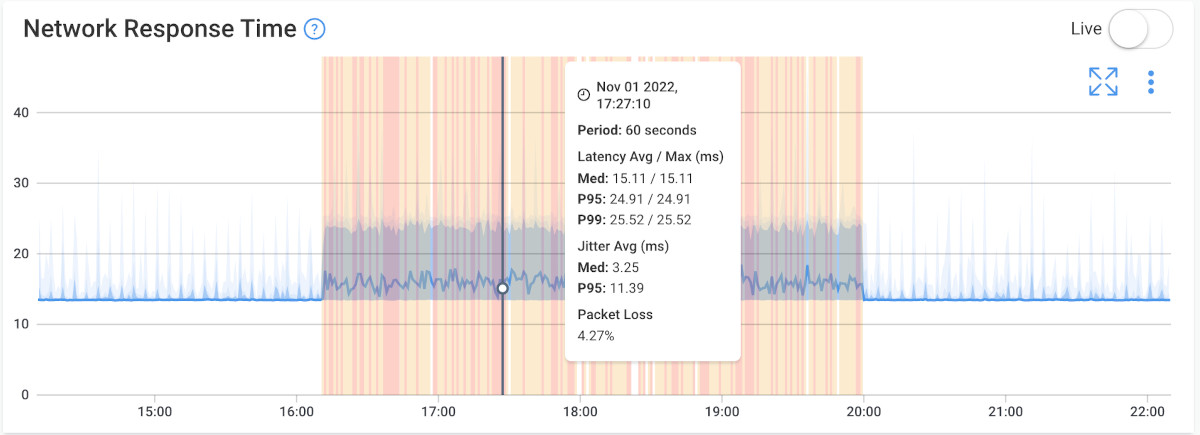
Ready to conquer the wild world of packet reordering and restore order to your network symphony? Look no further than Obkio's Network Performance Monitoring tool – your trusty wand to detect and tackle the mischievous out-of-order packets!
Obkio continuously monitors network performances to help identify and troubleshoot network issues, like packet reordering, packet duplication, packet loss, and more! With Obkio, you'll dive into a realm of real-time insights and powerful analytics, equipping you with the knowledge to detect and mitigate packet reordering with ease.

- 14-day free trial of all premium features
- Deploy in just 10 minutes
- Monitor performance in all key network locations
- Measure real-time network metrics
- Identify and troubleshoot live network problems

Packet reordering, or the occurrence of out-of-order packets, can be caused by various factors in computer networks.
In short, packet reordering can happen during network route changes due to the convergence of the network routing protocols (BGP, OSPF, EIGRP, etc.). This is normal and should not affect your applications that much because only a few packets will be reordered during a short period of time, and it should stop once the network is converged (i.e. the routes are stabilized).
If the packet reordering continues, it is probably caused by load balancing on multiple links. When configuring load balancing (or load sharing) on multiple links, the equipment must decide where each packet goes.
Here are some common causes of packet reordering in more detail:
In networks with multiple paths or routes, packets may traverse different routes with varying delays. These delays can result from differences in link capacities, congestion levels, or routing protocols. As a result, packets may arrive at the destination out of order, as they take different routes with different transmission times.
Load-balancing techniques distribute traffic across multiple network paths to optimize resource utilization and enhance performance. However, load balancing can introduce packet reordering if packets are divided among different paths and encounter different transmission latencies. This can lead to packets arriving at the destination out of sequence.
In some cases, packet processing within network devices or routers may occur in parallel across different processing units or cores. As a result, packets can be processed and transmitted in a non-sequential manner, potentially leading to packet reordering at the receiving end.
- When transmission errors occur, packets may be lost or arrive out of order. In response, network protocols employ mechanisms such as retransmissions to recover lost packets. However, retransmissions can introduce delays and result in out-of-order delivery if the original and retransmitted packets follow different paths or experience different transmission times.
Network congestion within a network can cause packets to experience varying delays or take alternative paths to avoid congested links. This can result in packets arriving out of order at the destination.
Jitter refers to the variation in packet delay, typically caused by fluctuations in network traffic or delays introduced by network devices. High levels of jitter can contribute to packet reordering, as packets may experience different delays during transmission and arrive at the destination in a non-sequential order.
Understanding the causes of packet reordering is crucial for network administrators and IT professionals, as it enables them to more easily identify signs of packet reordering and implement strategies to minimize its impact. But how can you actually detect packet reordering?
Let’s get into it!
When it comes to detecting packet reordering in your network, there are different techniques at your disposal (which we’ll cover in a bit). But the quickest, easiest and most proactive technique is by using Network Monitoring (or Network Performance Monitoring).
Network monitoring tools provide real-time monitoring capabilities, allowing you to capture and analyze network packets as they travel through your network. This proactive approach enables prompt detection and mitigation of packet reordering, minimizing its impact on network performance and user experience.
A network monitoring tool displays packet arrival sequences in real-time, allowing network administrators to visually identify and analyze out-of-order packets.
So how do you set this up? Let’s get to the step-by-step process!
Ready to get your packets back in order and unleash the full potential of your network? Look no further than Obkio's Network Performance Monitoring tool!
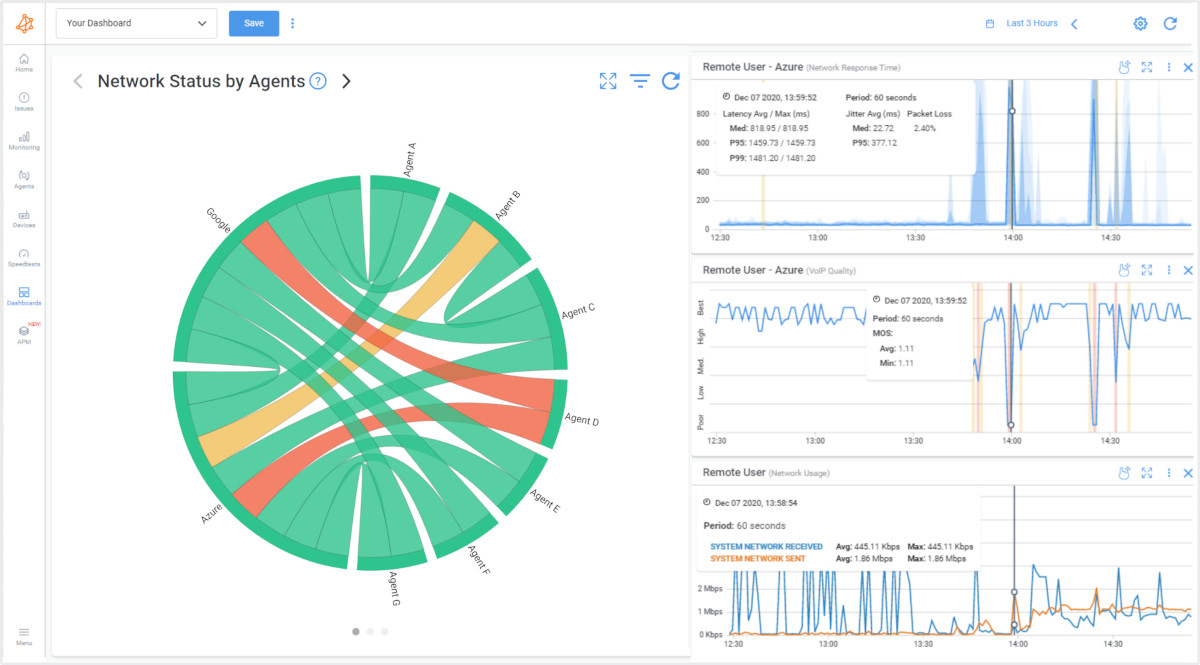
The only way to detect packet reordering is by sending packets at a very fast speed and then comparing the received packet order with what was sent. The delay between two packets must be minimal in order to catch the reordering.
Obkio’s Network Performance Monitoring algorithm sends packets every 500ms to measure network performance and catch issues. To detect packet reordering, Obkio uses packet bursts. Every minute or so, a burst of 5 packets is sent as fast as possible. If there is packet reordering, a Packet Reordering network issue will be raised with the severity Information.
Try Obkio’s Network Performance Monitoring and Packet Reordering features now!

As we mentioned above, Obkio detects packet reordering using continuous synthetic traffic from Network Monitoring Agents deployed in key network locations like offices, data centers and clouds. The Agents exchange synthetic traffic to measure network metrics, like packet reordering, between each other.
This will help you determine if, when, and where packet reordering is happening and identify any network segments where packet loss is most pronounced. Essentially, to detect packet reordering, you’ll need:
- Local Agents: Installed in the targeted office location experiencing network performance issues. There are several Agent types available (all with the same features), and they can be installed on MacOS, Windows, Linux and more.
- Public Monitoring Agent: These are deployed over the Internet and managed by Obkio. They compare performance up to the Internet and quickly identify if the problem is global or specific to the destination. For example, measure packet duplication between your branch office and Google Cloud.
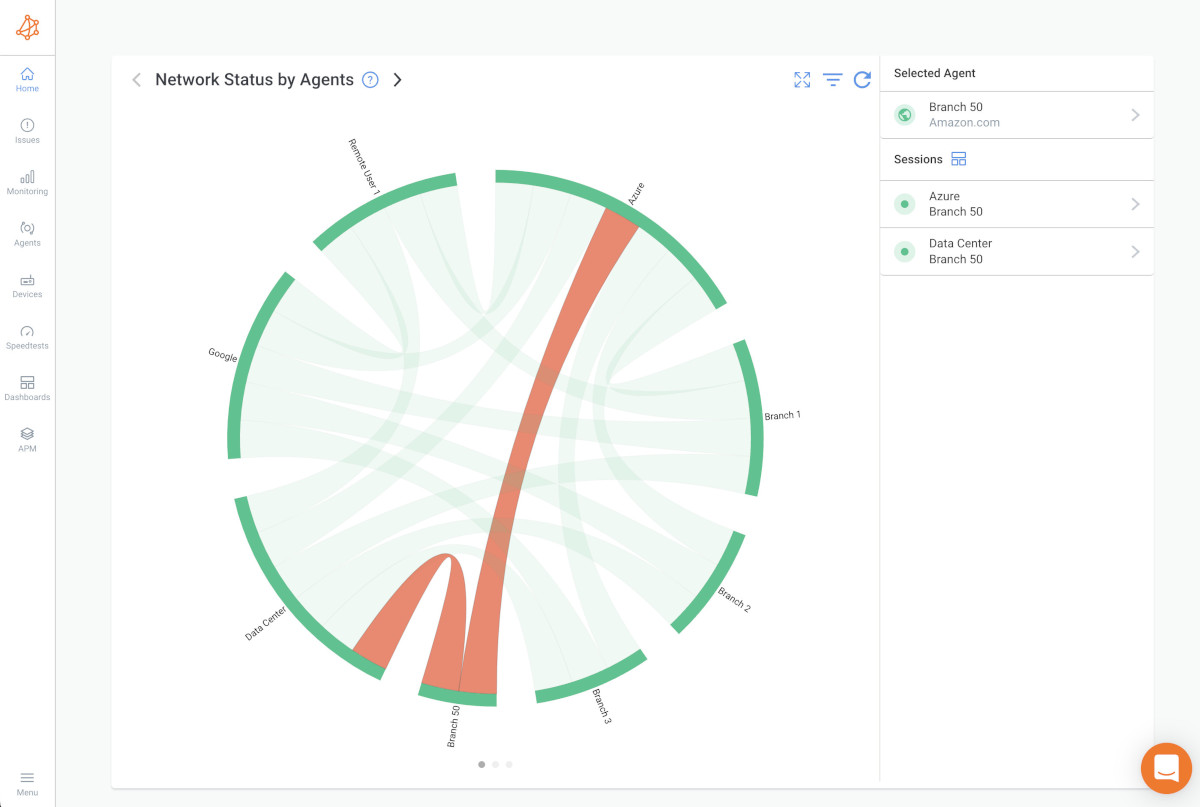
As we mentioned earlier, Obkio uses packet bursts to detect packet reordering. Every minute or so, a burst of 5 packets is sent as fast as possible. If there is packet reordering, a Packet Reordering network issue will be raised with the severity Information. Once the issue is raised, it will be cleared after 10 minutes if no more out-of-order packets are detected.
Obkio regroups all network issues alerts affecting a single Network Monitoring Session during a period of time. They are not always totally bad but it indicates that something has changed from the network performance baseline and it might need attention.
Most of the network events, like packet reordering, are based on thresholds that are configured in the Network Monitoring Templates.
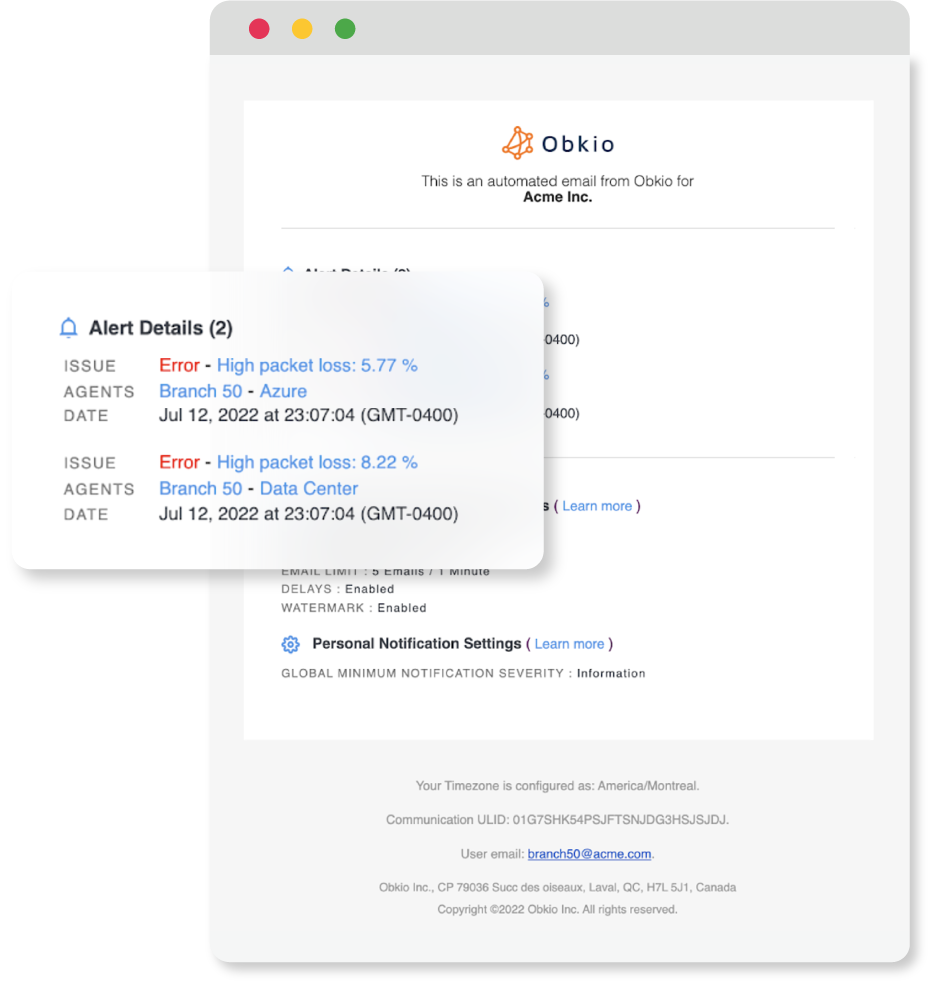

Since Obkio is a complete, end-to-end Network Performance Monitoring tool, it measures much more than just packet reordering. Obkio measured a variety of other network metrics which are crucial to ensuring optimal network performance and user experience as a whole.
And, because packet reordering can be caused by a variety of different factors, you can actually measure these other network metrics to detect packet reordering as well, Here are some key metrics to consider:
- Jitter: Jitter refers to the variation in packet delay caused by fluctuations in network traffic or delays introduced by network devices. High jitter values can indicate the potential for packet reordering.
- Gap Size: Gap size refers to the difference between the expected sequence number of a packet and the sequence number it actually arrives with. Measuring the size of these gaps helps identify the extent of packet reordering. Larger gap sizes indicate more severe reordering.
- Out-of-Order Packets Count: This metric simply counts the number of packets that arrive out of order. A higher count suggests a higher degree of packet reordering.
- Disorder Ratio: The disorder ratio measures the proportion of out-of-order packets relative to the total number of packets received. It is calculated by dividing the number of out-of-order packets by the total packet count. A higher disorder ratio indicates a higher level of packet reordering.
- Reordered Packets Rate: This metric represents the rate at which packets arrive out of order. It is calculated by dividing the number of out-of-order packets by the total time elapsed. The reordered packets rate provides insights into the frequency of packet reordering occurrences.
- Inter-Arrival Time Variance: Variance in inter-arrival times between packets can indicate the presence of packet reordering. Higher variance suggests irregularities in packet arrival patterns, which may result from out-of-order delivery.
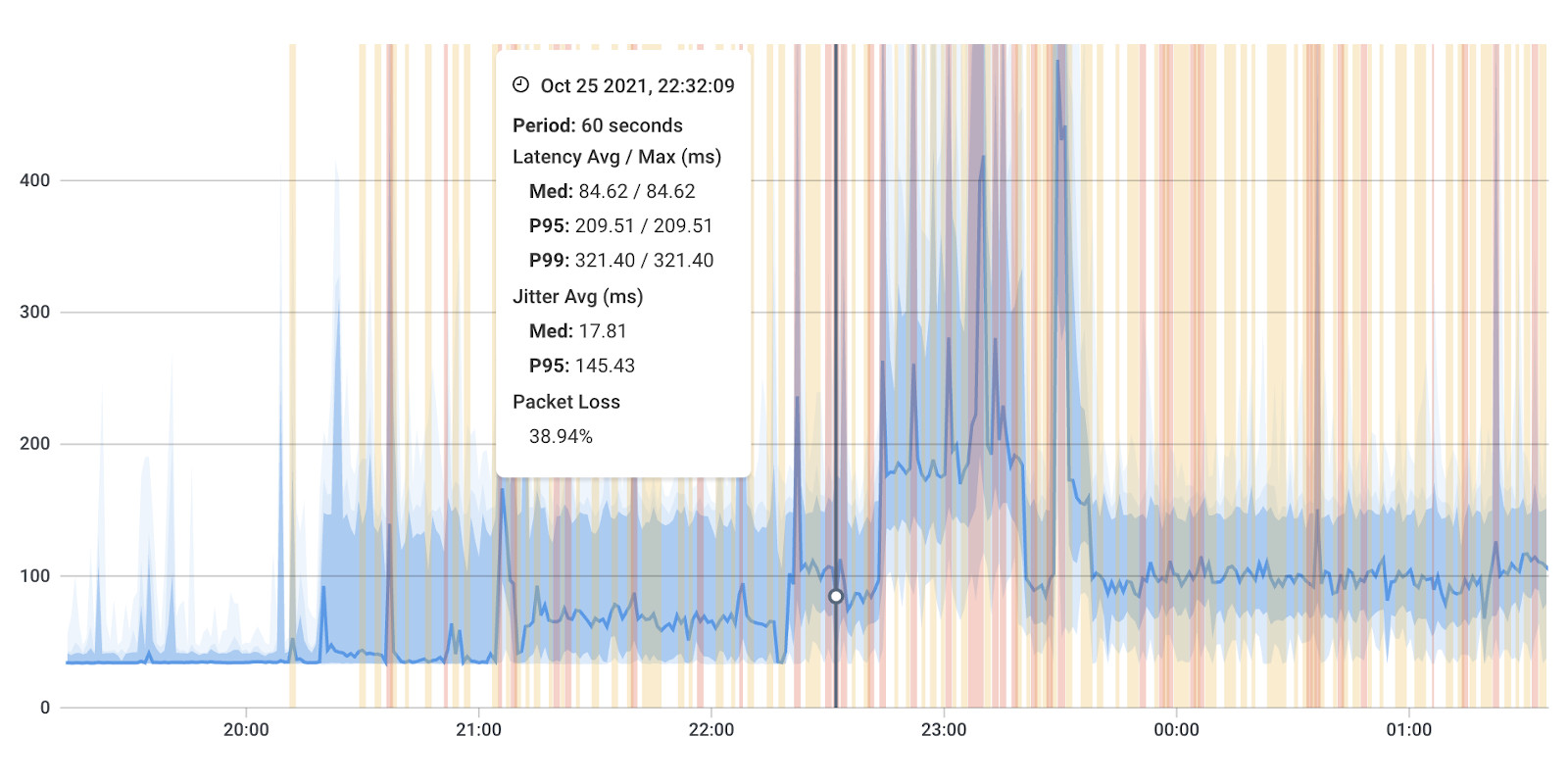
These metrics, along with techniques such as packet sequence number analysis, inter-arrival time analysis, and timestamp analysis, help network administrators and IT professionals assess the severity and impact of packet reordering on network performance.
Detecting packet reordering involves analyzing network traffic and identifying the presence of out-of-order packets. In the steps above, we taught you how to detect packet reordering using Network Monitoring, since it gives you the most complete view of your network performance, but there are several other techniques that can be employed to detect packet reordering. Here are some common methods:
Specialized network monitoring and visualization tools can provide insights into packet reordering. These tools track and display packet arrival sequences in real-time, allowing network administrators to visually identify and analyze out-of-order packets.


Many network protocols, such as TCP (Transmission Control Protocol), assign sequence numbers to packets. By examining the sequence numbers of received packets, one can identify gaps or inconsistencies that indicate out-of-order delivery. Analyzing the sequence numbers allows for straightforward detection of packet reordering.
This technique focuses on analyzing the time intervals between packet arrivals. By comparing the expected inter-arrival time (based on the packet transmission rate) with the actual observed inter-arrival time, deviations can be identified. Significant variations in inter-arrival times may indicate the presence of packet reordering.
Timestamps embedded in packets can be used to analyze the order of packet arrival. By comparing the timestamps of received packets, one can determine if packets are arriving in the expected temporal order. Deviations from the expected order indicate packet reordering.
Some network monitoring tools use pattern-matching algorithms to identify patterns in the arrival sequence of packets. By analyzing the patterns, these tools can detect anomalies or disruptions that suggest packet reordering. This approach can be particularly useful when dealing with large volumes of network traffic.
Statistical techniques can be employed to analyze packet arrival patterns and identify instances of packet reordering. This may involve measuring metrics such as gap size, variance in inter-arrival times, or other statistical indicators that highlight irregularities in packet sequencing.
It's worth noting that the effectiveness of these techniques can vary depending on network conditions, the protocols in use, and the specific characteristics of the traffic. Additionally, detection methods may need to be combined with mitigation strategies to address the impact of packet reordering on network performance effectively.
In this section, we'll equip you with the tools and techniques to track down the mischievous culprits behind packet reordering. We'll unravel the mysteries, overcome the challenges, and guide you step-by-step through the troubleshooting process.
Troubleshooting packet reordering requires a systematic approach to identify and resolve the underlying causes. Here are some steps you can follow to troubleshoot packet reordering issues:
Begin by analyzing the network performance to identify if packet reordering is occurring. This involves examining relevant metrics such as latency, jitter, throughput, and error rates with a Network Performance Monitoring tool, like Obkio. Look for signs of packet reordering, such as inconsistencies in packet delivery or deviations from expected performance levels. You can follow the steps we mentioned above to deploy this monitoring setup.
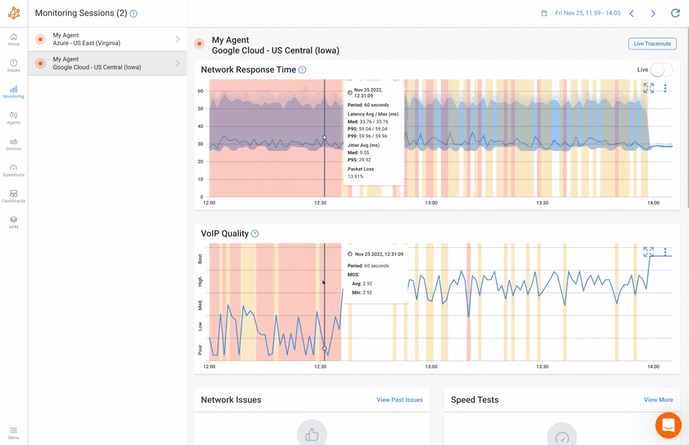

Once you have confirmed the presence of packet reordering, investigate the potential causes. Examine factors such as network topology, routing protocols, load balancing configurations, congestion levels, or transmission errors. Each of these factors can contribute to packet reordering, and understanding the root cause is crucial for effective troubleshooting.
Check the network configuration settings, including routers, switches, and load balancers, to ensure they are properly configured. Look for any misconfigurations or suboptimal settings that could contribute to packet reordering. Verify that routing protocols and network load balancing mechanisms are properly configured to ensure predictable packet delivery.
High latency and jitter can increase the likelihood of packet reordering. Measure and analyze latency and jitter values within the network to identify any areas of concern. Excessive latency or jitter may indicate network congestion, faulty hardware, or improper QoS settings.
Packet loss and transmission errors can lead to retransmissions and out-of-order delivery. Monitor packet loss rates and error rates within the network to identify any patterns or anomalies. Excessive packet loss or errors may require investigation into link quality, network device health, or potential interference.
Depending on the specific causes identified, implement appropriate mitigation techniques. This could involve adjusting network configurations, optimizing routing paths, implementing QoS mechanisms, or load-balancing strategies. Additionally, consider deploying reordering mitigation algorithms, such as selective acknowledgments (SACK) or forward error correction (FEC), to reduce the impact of packet reordering.
After implementing mitigation measures, validate the effectiveness of the changes by monitoring network performance. Continue to analyze relevant network metrics, such as gap size, disorder ratio, or out-of-order packet count, to ensure the packet reordering issue has been resolved or minimized.
If troubleshooting efforts do not yield satisfactory results or if packet reordering persists, consider seeking assistance from network experts or specialized support teams. They can provide advanced troubleshooting techniques, perform in-depth analysis, or offer recommendations tailored to your specific network environment.
Remember, troubleshooting packet reordering may require a combination of diagnostic tools, network configuration adjustments, and continuous monitoring. By following a systematic troubleshooting process, you can identify and address the underlying causes of packet reordering, thereby improving network performance and reliability.
Within the world of Packet Reordering, there is a very specific instance of TCP packet reordering.
TCP (Transmission Control Protocol) is a reliable, connection-oriented protocol used in computer networks to ensure the ordered and error-free delivery of data between devices. However, sometimes in complex network environments or due to various issues, TCP packets can arrive at their destination out of order. This means that the data segments that make up a TCP connection are not received in the sequence they were sent.
There are several reasons why TCP packets can become out of order:
- Network Congestion: In situations where there is network congestion or heavy traffic, packets can be delayed or take different routes to reach their destination. This can result in packets arriving out of order.
- Multiple Paths: In some network architectures, data can be split and sent over multiple paths for load balancing or redundancy. Packets sent over these different paths may arrive at their destination out of order.
- Reordering in Transit: Some network devices or routers may reorder packets as they pass through them for optimization or security reasons. This can also lead to out-of-order packet delivery.
- Packet Loss and Retransmissions: If some packets are lost during transmission, TCP will request retransmissions of the missing packets. The retransmitted packets can arrive out of order if they take a different path or encounter different delays than the original packets.
TCP is designed to handle out-of-order packets. It uses sequence numbers to track the order of incoming packets, and it will reassemble them in the correct order before delivering the data to the application layer. This ensures that the data is reconstructed in the proper sequence even if some packets arrive out of order.
TCP uses acknowledgment (ACK) mechanisms to inform the sender about the receipt of packets and to request retransmissions of missing packets. This, along with sequence numbers, helps TCP recover from out-of-order packet delivery and other network anomalies to provide a reliable and ordered data transfer service.
1. Sequence Numbers:
- TCP assigns a unique sequence number to each TCP segment it sends. These sequence numbers are used to order and track the data packets in a TCP connection.
- When a sender (e.g., a web server) transmits data, it segments the data into packets and assigns sequence numbers to each packet.
- The sequence numbers are essential for the receiver (e.g., a web browser) to reassemble the packets in the correct order. These numbers allow the receiver to detect if any packets are missing or arrive out of order.
2. Acknowledgments (ACKs):
- After receiving TCP packets, the receiver sends acknowledgment packets (ACKs) back to the sender to confirm the receipt of the packets.
- The ACK packet typically contains the sequence number of the next expected packet. For example, if the receiver has received packets with sequence numbers 1, 2, and 3, it sends an ACK with an acknowledgment number of 4 to indicate that it is expecting the next packet to have a sequence number of 4.
- If the receiver detects missing or out-of-order packets, it will not acknowledge the packets that are out of order or request retransmissions for the missing packets.
3. Handling Out-of-Order Packets:
- When out-of-order packets are detected at the receiver, it does not acknowledge those packets, and it does not deliver them to the application layer.
- Instead, the receiver buffers the out-of-order packets until the missing or out-of-order packets arrive or are retransmitted.
- The receiver uses the sequence numbers to determine the correct order in which to deliver the data to the application.
- Once the missing or out-of-order packets are received, the receiver reorders them and delivers the data to the application in the correct sequence.
4. TCP Retransmissions:
- If the receiver doesn't receive a packet or an ACK within a certain timeout period, it assumes that a packet may have been lost and requests the sender to retransmit the missing packet.
- This retransmission mechanism helps ensure that even if a packet is lost or arrives out of order, the data can be reconstructed correctly.
In summary, the combination of sequence numbers and ACKs in TCP is crucial for maintaining the ordered and reliable delivery of data. Sequence numbers allow the receiver to keep track of packet order, detect missing or out-of-order packets, and reassemble the data correctly. ACKs are used to confirm the receipt of packets, request retransmissions when necessary, and signal the expected sequence number for the next packet. This cooperative mechanism ensures that out-of-order packets and other network anomalies do not disrupt the integrity of the data transfer.

TCP out-of-order packets can have several effects on a TCP connection and the applications using it:
- Delayed Data Delivery: Out-of-order packets can delay the delivery of data to the application layer. When packets arrive out of order, TCP must spend time reordering them before delivering the data to the application. This can introduce additional latency, especially for applications sensitive to delay, such as real-time communication or video streaming.
- Increased Processing Overhead: TCP must reassemble out-of-order packets into the correct order before delivering them to the application. This requires additional processing and memory resources on both the sender and receiver, which can affect the overall performance of the system.
- Retransmissions: In some cases, out-of-order packets can trigger retransmissions. If a sender detects missing packets (either due to packet loss or out-of-order delivery), it may request retransmissions, which can lead to increased network traffic and further delays.
- Reduced Throughput: Out-of-order packets can lead to a reduction in TCP throughput. When packets arrive out of order, TCP may need to slow down its data transmission rate to allow for the reordering of packets and to avoid congestion or buffer overflows.
- Application Impact: Depending on the nature of the application, out-of-order packets can have varying effects. For example, in web browsing, it may result in slower page load times, while in video streaming, it could cause buffering or degradation in video quality.
- Connection Instability: If out-of-order packets are not managed properly and cause excessive retransmissions or severe delays, it can lead to connection instability and even connection termination in extreme cases.
TCP reorders packets using sequence numbers and acknowledgment messages. Here's how it works:
1. Sequence Numbers: TCP assigns a sequence number to each segment (packet) it sends. These sequence numbers help in ordering the packets correctly at the receiver's end.
2. Acknowledgment (ACK) Messages: When a receiver gets a packet, it sends an acknowledgment message back to the sender. This ACK message contains the next expected sequence number that the receiver is ready to receive.
3. Out-of-Order Packets Handling:
- If packets arrive out of order at the receiver, TCP buffers them until it receives the missing packets to maintain correct sequencing.
- When the missing packet arrives, TCP can reorder the packets based on their sequence numbers before delivering them to the application layer.
4. Retransmission: If a packet is lost or not acknowledged within a certain timeout period, TCP retransmits that packet. This ensures that all packets are eventually delivered in the correct order.
In summary, TCP out-of-order packets refer to the situation where TCP segments arrive at their destination in a different order than they were sent due to network-related issues. TCP is designed to handle this and reassemble the data in the correct order before delivering it to the application layer.
UDP (User Datagram Protocol) differs significantly from TCP (Transmission Control Protocol) in how it handles packet delivery. Unlike TCP, which is connection-oriented and focuses on reliable, ordered delivery of data, UDP is connectionless and prioritizes speed and simplicity.
So, does UDP fix packet reordering? Simple answer is: No, UDP (User Datagram Protocol) does not reorder packets.
Unlike TCP, UDP does not use sequence numbers or acknowledgment messages for packet ordering or reliable delivery. In UDP, each packet is sent independently, without establishing a connection or maintaining a session state. This means UDP does not use sequence numbers to order packets or acknowledgment messages to confirm receipt. As a result, UDP packets are delivered as-is, without reordering or retransmission if they are lost or arrive out of order. This can also lead to UDP packet loss.
It's designed for applications where real-time communication and speed are prioritized over reliability and packet ordering, such as video streaming, online gaming, and VoIP (Voice over IP) services.

Reducing packet reordering in a network is essential for maintaining optimal performance and ensuring reliable data transmission. Before we let you on your way, we want to ensure you have everything you need to detect, troubleshoot and reduce packet reordering in your network, so here are a few tips to keep you proactive!
- Optimize Network Path and Routing: Review your network topology and routing configurations to ensure efficient and predictable packet delivery. Use protocols and mechanisms that prioritize ordered packet transmission, such as MPLS (Multiprotocol Label Switching) or strict source routing.
- Implement Quality of Service (QoS): QoS mechanisms prioritize certain types of traffic over others, reducing the chances of packet reordering. By implementing QoS policies and traffic shaping techniques, you can ensure that latency-sensitive or time-critical traffic receives preferential treatment, minimizing the impact of reordering.
- Load Balancing Strategies: If your network employs load balancing across multiple paths, ensure that load balancing algorithms are configured appropriately. Consider using algorithms that take packet ordering into account, such as weighted round-robin or least-connections. This helps maintain packet order by directing traffic consistently across paths.
- Path MTU Discovery: Path Maximum Transmission Unit (MTU) discovery allows hosts to determine the maximum packet size supported by the path. Ensuring proper Path MTU Discovery is in place helps prevent fragmentation and subsequent reordering of fragmented packets.
- Packet Reordering Mitigation Algorithms: Implement packet reordering mitigation algorithms, such as Selective Acknowledgments (SACK) in TCP, which allow receivers to selectively acknowledge out-of-order packets and request retransmissions. Forward Error Correction (FEC) techniques can also be employed to recover lost or reordered packets without the need for retransmissions.
- Monitoring and Analysis: Utilize network monitoring and analysis tools to continuously monitor packet reordering metrics such as gap size, disorder ratio, or out-of-order packet count. Regularly analyze these metrics to identify trends, patterns, or specific sources of packet reordering. This helps you proactively address issues and optimize network performance.
- Traffic Engineering: Employ traffic engineering techniques to manage network congestion and reduce the likelihood of packet reordering. This includes traffic shaping, traffic prioritization, and traffic optimization strategies to ensure smooth and ordered packet delivery.
- Network Testing and Simulation: Conduct network testing and simulation exercises to evaluate the performance of your network under different conditions, including packet reordering scenarios. This helps identify potential issues and validate the effectiveness of mitigation techniques before deploying them in production.
Remember that the effectiveness of these tips may vary depending on your specific network environment and requirements. It's essential to carefully analyze and tailor these recommendations to address the specific causes and characteristics of packet reordering in your network.
Discover the secrets of packet duplication in networks, learn how to identify it, and unleash the power of Obkio's monitoring tool to tackle the issue.
Learn more

In conclusion, packet reordering can be a puzzling challenge for IT pros and network admins. It's like a mischievous game where packets decide to break free from their orderly sequence, causing confusion and impacting network performance. However, armed with the right tools and knowledge, you can detect and mitigate packet reordering effectively.
By utilizing techniques like packet sequence number analysis, inter-arrival time analysis, and timestamp analysis, you can uncover the telltale signs of out-of-order packets. Monitoring network metrics such as gap size, disorder ratio, and inter-arrival time variance provides valuable insights into the extent and impact of packet reordering.
But why stop at detection when you can take control with a powerful network performance monitoring tool like Obkio?

With Obkio's comprehensive suite of features, you can not only detect packet reordering but also proactively optimize your network for peak performance. From real-time monitoring and network visualization to in-depth analysis and reporting, Obkio empowers you to conquer packet reordering and ensure smooth, efficient data transmission.
So, don your network superhero cape and join forces with Obkio to tame the mischievous packet-reordering beasts. Don't let them wreak havoc on your network's performance. Take action today and try Obkio's Network Performance Monitoring tool to uncover, diagnose, and conquer packet reordering challenges like a true IT pro!
- 14-day free trial of all premium features
- Deploy in just 10 minutes
- Monitor performance in all key network locations
- Measure real-time network metrics
- Identify and troubleshoot live network problems


























 Obkio Blog
Obkio Blog






